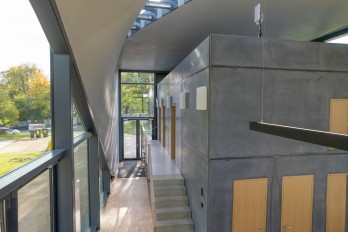Concrete that traps CO2 emissions for good

A new method to produce concrete that traps harmful CO2 emissions and increases the compression strength is implemented by Carbocure, a Canadian Start-up company.
While being the most abundant man-made material on earth, concrete poses a threat to the environment since its essential ingredient, cement, has a huge carbon footprint. Cement is the binder that bonds the aggregate together making concrete strong but the process of making cement requires superheating calcium carbonate, or limestone, and releases massive amounts of carbon dioxide into the atmosphere.
According to The International Energy Agency, cement is responsible for 7% of global greenhouse emissions, making it the world's second largest industrial source of carbon dioxide. The scientific agency of the US government (United States Geological Survey) reveals that global cement production was responsible for about 4 billion pounds of CO2 emissions in 2017 alone. The way that this method absorbs CO2 is by injecting the captured gas into concrete as it is being mixed. Over time, concrete hardens trapping the carbon inside. Even if the construction that the concrete is used for collapses, the carbon is not emitted in the atmosphere. That's because it reacts with the concrete and becomes a mineral. This reaction provokes another beneficial effect as it improves the compressive strength of the concrete, according to Christie Gamble, director of sustainability at CarbonCure. "The best thing about it is the mineral itself improves the compressive strength of the concrete. Because the CO2 actually helps to make the concrete stronger, concrete producers can still make concrete as strong as they need to but use less cement in the process."
Thomas Concrete of Atlanta has been using the CarbonCure system since 2016. The company says it has prevented 10 million pounds of CO2 emissions since it adopted the process. Justin Lazenby, manager of technical operations at Thomas Concrete, told CNNMoney that the move toward greener tech is a long-term decision that should be embraced by the concrete industry. "The industry as a whole has always kind of looked at trying to solve today's problems with yesterday's technology, which doesn't really work". Thomas Concrete has an agreement where it pays to use the CarbonCure system and buys captured CO2 from a fertilizer plant. The company says the savings they see by using less cement equal the costs involved with the system. "We understand that to make environment impact, you have to make business sense," CarbonCure's Gamble said. 725 Ponce, a new mixed-use development in Atlanta will become one of the largest structures ever made with CarbonCure concrete when it opens next year.
Two other startups (Carbicrete and Carbon Upcycling) working on more sustainable solutions for concrete exist. CarbonCure is just one of the first to market. Gregg Lewis, executive vice president of strategy for the National Ready-Mix Concrete Association, said these types of technologies will help push the concrete industry toward a more sustainable future. "[It will] offer a huge advantage to how we build as an industry," he said to CNNMoney. CarbonCure's Gamble noted if the industry is able to reduce 5% of its carbon footprint, that is a significant change from where it is right now. "If this technology is deployed across the globe, we could reduce about 700 megatons of CO2 each year. That's the same as taking 150 million cars off the road every year," Gamble said. To sum up, despite the fact that there is no intention to replace concrete production, it is feasible to promote new methodologies improving its negative effect on the environment.
Sources: Money.cnn.com (Video included), EnergiNews
Want to read more like this story?

Concrete is a climate disaster and thus it’s time to clean it up
Oct, 29, 2021 | NewsFor soaring bridges, dramatic skyscrapers and even the path around your local park, builders love c...
Concrete Structures
Jan, 01, 2019 | EducationConcrete structures are constructions that utilize concrete as the primary building material. Conc...

The world’s first carbon concrete building constructed by researchers in Germany
Nov, 10, 2022 | NewsThe first building made of carbon-reinforced concrete was inaugurated in September after two and a...

Discarded plastic bottles could be used to make stronger concrete
Jan, 15, 2018 | NewsMIT students have found a way to produce plastic-reinforced concrete that is up to 15% stronger than...

Cement's production high environmental footprint
Jul, 24, 2019 | NewsThe production of cement results in more pollution in the environment than all the trucks and just 1...

Concrete damage based on 4 crucial factors
Feb, 01, 2024 | NewsConcrete often sustains damage due to various factors, either environmental or mechanical. In the f...

Concrete - FIN EC
Oct, 19, 2023 | Software
New solution promises 90% cost reduction in concrete 3D printing materials
Dec, 22, 2021 | NewsConcrete 3D printing of building shells has grown considerably in the last few years, with more and...

This new construction system allows affordable and easy to build concrete walls of any shape, thickness and size
Aug, 08, 2017 | NewsThe company claims that about half the time or less is needed to erect a residential structure compa...
Trending

Spectacular interchanges around the world

Eshima Ohashi bridge in Japan designed for the brave!

Building partially collapses in Philippines: 2 people injured

Concrete Component Design Using STAAD.Pro

Underground tunnel and Yonge Station project in downtown Toronto



